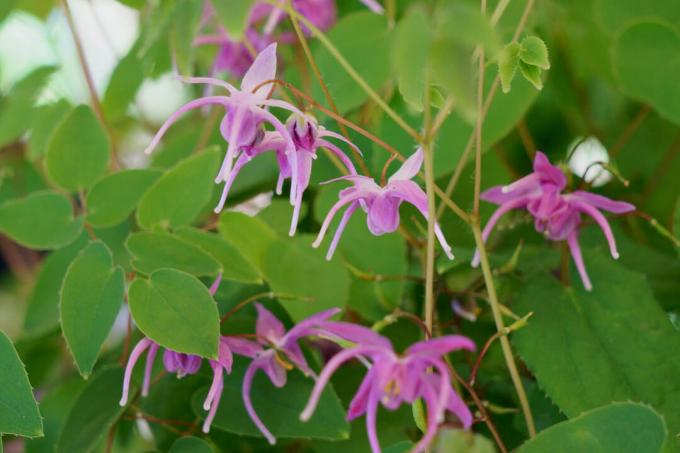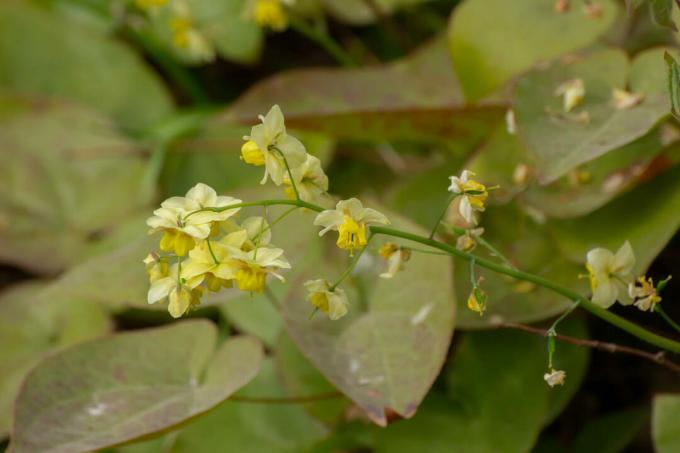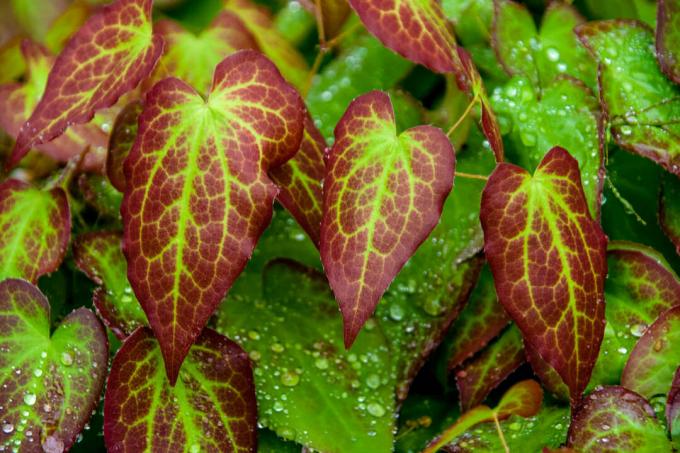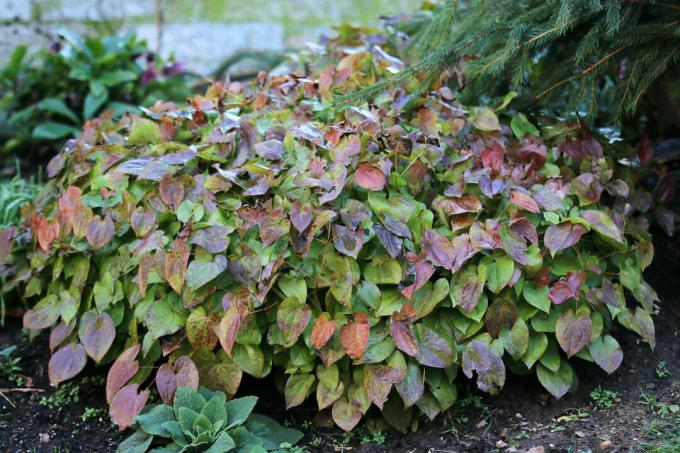The shade-tolerant elf flower is particularly suitable as an underplanting and as a ground cover. We give tips on choosing a variety, planting and propagating the elf flower.

One of the best-known shade plants is the elf flower. We present you the most beautiful ones epimediumspecies and varieties and give tips on planting and care.
contents
- Elf Flower: flower, origin and properties
- The most beautiful elf flower varieties
- Plant elf flower: location, time & procedure
- Caring for the elf flower: cutting, watering and fertilizing
- Propagating Elf Flower
- wintering
- Is the elf flower poisonous?
Elf Flower: flower, origin and properties
The Elf Flower (epimedium), also known as the sockflower, belongs to the barberry family (Berberidaceae). Its approximately 60 species and natural hybrids are found in Asia, Africa and Europe in the northern hemisphere. The deciduous or evergreen perennials overwinter with the help of their rhizomes, some of which form runners. Elf flowers reach a height of between 15 and 40 centimeters. Their leaves are ovate, heart-shaped, lanceolate-elongated or almost round in shape. The edge of the leaf can be serrated or slightly thorny. The shoots in spring are often bronze or reddish, in autumn the foliage is usually wine-red-green to violet-red. The flowering period of the elfin flower begins in April, sometimes before or during the leaves sprout. The fourfold flowers consist of four inner and four outer petals and can form elongated spurs depending on the species. After pollination, capsule fruits form, inside which there are numerous seeds with a conspicuous seed coat. Ants love to feed on the nutritious coat, spreading the Elf Flower Seeds around.
Is the elf flower bee friendly? The elf flower is one of the bee perennials. Smaller wild bees in particular use the nectar and pollen offered by the often delicate elfin flowers. Large-flowered species like Epimedium versicolor are also visited by honey bees.

The most beautiful elf flower varieties
There are different types and varieties of elven flowers, which differ in growth, flower size and coloration. We present you the 10 most beautiful types and varieties of the epimedium in front.
- Epimedium alpinum: Alpine lily from south-eastern Europe with deciduous foliage and a growth height of up to 40 cm. The wild species that produces runners forms dainty panicles with up to 25 red-yellow individual flowers.
- Epimedium grandiflorum: The large-flowered elf flower originally comes from Japan. It has a deciduous, clumpy growth of up to 25 cm and long, spurred, large, orchid-like flowers. The elf flower 'Lilafee' is bronze-colored when it shoots and delicate purple, filigree flowers from April.
- Epimedium pauciflorum: Few-flowered elfin flowers with a low stature and 15-20 cm in height. Popular as groundcover as the short runners form a dense, evergreen carpet. The rather weak species shows delicate pink to creamy white flowers.
- epimedium x perralchicum: Hybrid species with dense growth up to 30 cm and almost evergreen leaves. Elf flower 'Frohnleiten' is the best-known variety and can be planted as ground cover. The leaves turn a pretty red in autumn while the veins remain light green. The delicate flowers of the hybridepimedium 'Frohnleiten' set yellow accents.

- Epimedium pinnatum ssp. colchicum: Black Sea elvenflower with vigorous growth and almost evergreen leaves. The delicate, light yellow flowers appear from April. The 'Black Sea' variety turns its leaves dark purple in autumn and winter. It is particularly suitable for wide-area use, including under shrubs and trees.
- epimedium pubic: Downy elfin flower with hardy evergreen leaves and clumpy growth up to 25 cm high. The short-spiked, light yellow flowers are on long peduncles.
- epimedium x rubrum: Red elfin flower, resulting from a cross between E alpine and E grandiflorum. The clumpy, deciduous plants have red-brown leaves and bicolored red-white flowers. The particularly free-flowering variety 'Galadriel' can be used well as a ground cover.

- Epimedium versicolor 'Sulphureum': Very vigorous sulfur elven flower up to 35 cm and with strong spreading. The sulphur-yellow flowers appear from April to May. In autumn, the foliage of the 'Sulphureum' elfflower turns bronze.
- epimedium x warleyense: The deciduous hybrid elven flower, up to 30 cm high, forms runners and is therefore ground-covering. epimedium 'Orangekönigin' is also available as 'Orange Queen' and has numerous pale orange-red flowers.
- epimedium x youngianum: Low deciduous hybrid of E grandiflorum x E diphyllum, between 15 and 20 cm high. The variety of epimedium x youngianum 'Niveum' has spurless, white flowers and a delicate habit and is ideal for underplanting.

Elf flowers as ground cover: The following types of elfin flowers are particularly suitable as ground cover: Epimedium pauciflorum, epimedium x perralchicum 'cheerful', Epimedium pinnatum ssp. colchicum and epimedium x warleyense.
Plant elf flower: location, time & procedure
epimedium is generally an adaptable perennial for partially shaded to shaded locations. Locations that are too bright endanger hibernation due to late frosts, few flowers are formed in locations that are too dark. The ideal location for elf flowers is on fresh, loose, low-lime and slightly acidic, humus-rich soil. Soil that is too heavy or sandy can be treated with a high-quality potting soil such as ours Plantura organic potting soil, to be improved. In addition, powdered clay increases the water storage capacity of the soil.
Elf flowers are planted in late autumn, between October and the end of November before the first frosts, or in early spring from the beginning of March. They can be planted under shrubs and trees or in shady beds. epimedium prefers to be planted in small groups of three to ten plants and is most appealing that way. The planting distance for elfin flowers is about 30 to 40 cm. For ground cover you need about 15 to 17 plants per square meter. The perennials are planted as deep as they were previously in the pot. In the course of three to four years, the foothills of growing species have taken over the new location. Elf flowers usually bloom in the first spring after planting.
Caring for the elf flower: cutting, watering and fertilizing
You don't necessarily have to cut the elf flower. However, it can make room for new growth if the old leaves are removed after winter, around March.
The elfin flower is a low-maintenance perennial that requires little attention once planted. A layer of mulch between the freshly planted perennials protects them from drought and heat. More sensitive species from Asia, such as E grandiflorum and E pubescence,should be watered regularly in the hot season. Southern styles, like E perralchicum and E pinnatum, are more robust and endure heat and drought well.

Fertilization can be done annually in spring as needed. A predominantly organic long-term fertilizer, like ours Plantura organic flower fertilizer, should be scattered loosely over the stock of elf flowers from March if the ground is frost-free. Ideally, water well afterwards so that the nutrients are released quickly.
Propagating Elf Flower
The simplest method of propagation is the division of existing clumps. In late spring after flowering, the rhizomes of the elfin flowers can be divided with a spade, dug up and replanted in the appropriate place.
Alternatively, elf flowers can also be propagated via rhizome cuttings. For this purpose, the rhizomes of excavated plants are cut into pieces about 5 cm long with a sharp knife. Then the rhizome pieces are placed horizontally in nutrient-poor potting soil and covered with substrate about 1 to 2 cm thick. In the coming weeks, the cuttings should be allowed to root in a moist but not wet place in a bright, cool location. The first shoots and leaves will soon appear. Once strong plants have developed, the elf flowers can be transplanted or planted out.

wintering
In our latitudes, the common types of elfin flowers are very hardy. Freshly planted and deciduous elfin flowers should be given some light winter protection, such as a thick layer of foliage, in harsh locations. The rhizomes only spread just below the surface of the soil and can therefore be damaged in severe sub-zero temperatures.
Is the elf flower poisonous?
The elf flower is considered a slightly poisonous plant. In some countries, however, parts are cooked and thus made edible. In folk medicine, extracts of E grandiflorum used in certain cancers.
tip: The two types of Elfin Flower Epimedium macun and Epimedium brevicornum are used in traditional Chinese medicine and herbal medicine as medicines for thyroid problems, high blood pressure and erectile dysfunction.
Ground-covering plants are suitable in many gardens as underplanting or additional greening of beds. Discover more with us bee friendly ground cover for each location.
